Hygienic Ceilings: Keeping it clean overhead
by Katie Daniel | December 28, 2016 3:15 pm
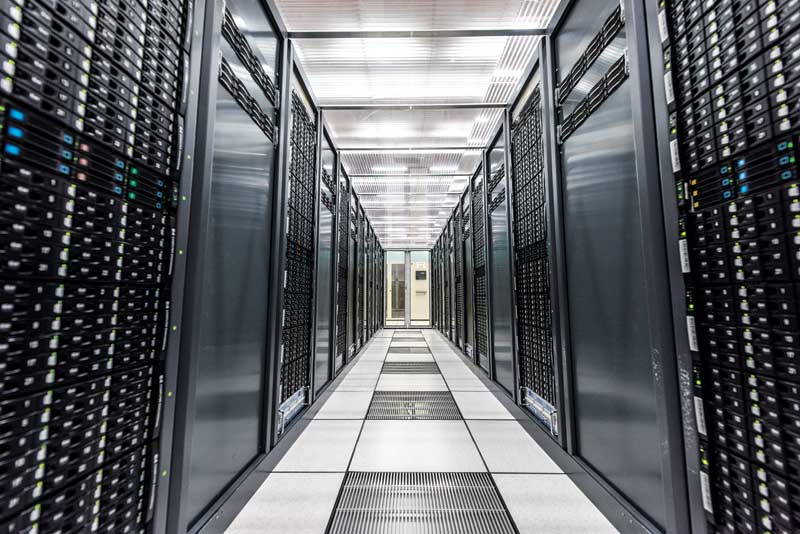
by Ed Davis, David Condello, and Michael Chusid, RA, FCSI, CCS
Room finishes should be specified with regard to the level of cleanliness required in a space and the resources available for maintenance of finished surfaces. Standards for cleanliness are often lax, especially when it comes to ceilings. Room occupants seldom have direct contact with these overhead surfaces, so dust, grime, splatters, greasy kitchen smoke, and other contaminants accumulate. (Cleaning is usually postponed until visible surfaces become aesthetically objectionable.) Other spaces, such as cleanrooms and surgeries, require smooth, monolithic, or well-sealed ceilings free of crevices and ledges that can be maintained at the highest cleanliness levels. Between casual commercial criteria and the rigors of nearly sterile environments is the category of products used for hygienic ceilings.
While no standard defines hygienic ceilings, the category generally consists of lay-in ceiling panels that:
- do not attract or harbor contaminants;
- are benign to the indoor environment; and
- can be cleaned or disinfected without damaging their appearance or function.
Closely related to the concept of sanitation, the term ‘hygienic’ refers to conditions and practices helping maintain health and prevent spread of diseases. It applies to ceilings in spaces sensitive to microbes, toxins, and other biohazards. Examples include:
- commercial kitchens and culinary areas;
- hospital and healthcare facilities;
- nursing homes;
- elementary schools;
- animal and veterinary facilities; and
- laboratories.
In this article, ‘hygienic’ also describes conditions and practices necessary to avoid contamination in manufactories and other facilities, even though special attention to health and disease are not of primary concern. For example, hygienic practices contribute to quality assurance, reduce fire hazards by removing combustibles from interior surfaces, optimize energy consumption by improving lighting efficiency, contribute to workplace safety by reducing labor required to clean overhead surfaces, and simplify final cleaning at the end of a construction or remodeling project.
Hygienic ceiling products are manufactured in a variety of materials and styles. The plethora of products enables designers to specify solutions meeting acoustic, fire safety, aesthetic, and other criteria in addition to hygienic characteristics. Many building types requiring hygienic ceilings have regulatory requirements and industry guidelines for hygienic finishes. (This topic is further explored in a web feature, “Hygienic Ceilings: Standards and Guidelines,” posted on The Construction Specifier website. Visit www.constructionspecifier.com/more-hygienic-ceilings[1].)
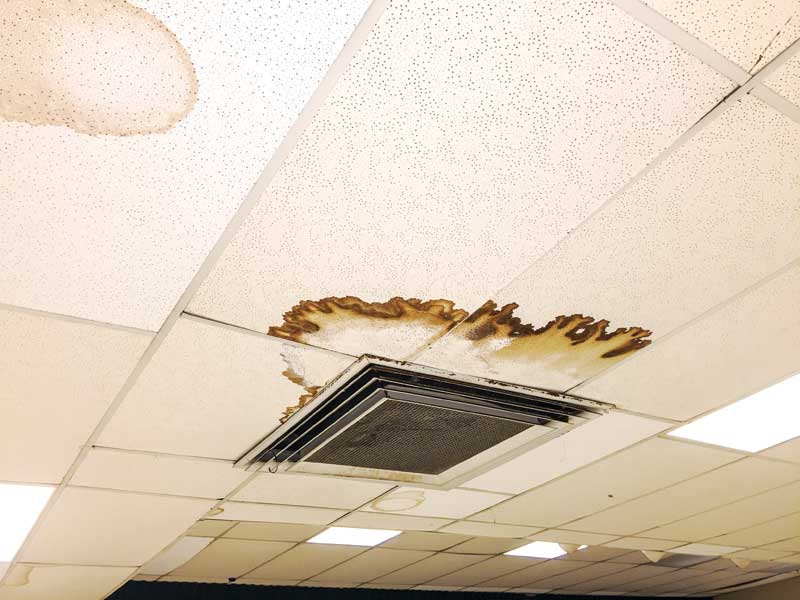
Photo courtesy Michael Chusid
Types of panels
Products from various manufacturers in each of the following ceiling categories have unique performance and properties; specifiers must weigh proposed products against project requirements. Those unfamiliar with product performance under similar conditions of use should ask for test reports or other documentation of product claims. Some products in each category are available with Class A surface burning characteristics and low emissions of volatile organic compounds (VOCs).
All products discussed in this article are offered in white (and other colors with good light reflectivity), and have smooth, or otherwise easily cleaned, surfaces. They can also be installed in grids complying with ASTM C635, Standard Specification for Metal Suspension Systems for Acoustical Tile and Lay-in Ceilings, with the proviso that suspension systems and accessories must be hygienically compatible with the ceiling panels. In some situations, for example, it may be necessary to use ceiling grid members with built-in gaskets to seal crevices and ledges.
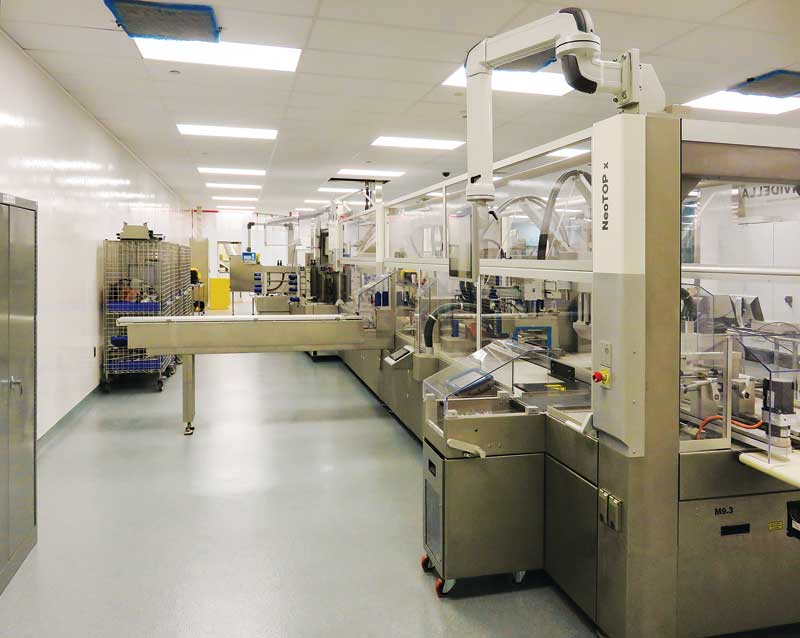
Photo courtesy Crane Composites
Mineral fiber
Mineral fiber panels generally provide good acoustical properties, including noise reduction coefficients (NRC) and ceiling attenuation coefficients (CAC). They can also be used in floor-ceiling assemblies providing good sound transmission coefficients (STC). Certain mineral fiber panels can be used in fire-resistance-rated floor-ceiling assemblies.
Panels are made of synthetic vitreous fibers such as glass, rock, or slag wool and a binder. These fibers have an inherent limitation regarding hygienic use—fibers are friable and can be dislodged, rendering panels visually less attractive and potentially releasing fibers into a room. To overcome this, mineral fiber panels for hygienic ceilings are typically faced with plastic or metal foil, or another readily cleanable surfacing agent.
While fibers do not migrate through the faced surface, they can still be released while cutting, handling, installing, and maintaining panels. Mineral fiber panels are frangible, with corners and edges potentially breaking off when accessing the above-ceiling cavity. While each incident may release only a small quantity of fibers, they can accumulate and eventually pose problems. In some especially sensitive areas, even a small quantity of fibers can be unacceptable.
The safety data sheet for a typical mineral fiber ceiling panel promoted for use in healthcare and food-processing areas warns installers they should work in well-ventilated worksites, avoid breathing dust, wash thoroughly after handling, and “obtain special instructions before use.” Recommended personal protective equipment includes splash-resistant safety goggles with a face shield, chemical-resistant clothing and gloves, and, under certain conditions, respirators approved by National Institute for Occupational Safety and Health (NIOSH). The safety data sheet also states the product can cause skin, eye, and respiratory tract irritation, be a cancer hazard, or lead to lung damage. These statements may be hyperbole required by product liability attorneys—indeed, the safety data sheet also says ill effects are not expected during “normal use” and do not present known health effects when properly installed and maintained.
Therein may lie the rub. Occupancies requiring hygienic conditions are not “normal use.” Further, it is hard to ensure products will be properly maintained; removing panels for above-ceiling access can dislodge fibers, and it may be impractical to shut down a facility every time the ceiling is touched.

Photo courtesy Paradiso Pizza and Subs (Kingston, Ontario)
Most mineral fiber products have the propensity to absorb water and support fungi—thus, the potential for mold and mildew spores can be a concern. Many mineral fiber panels promoted for hygienic conditions have antimicrobial treatments (a topic discussed later in the article), but surface-applied coatings do not provide protection to panel cut edges or penetrations.
Some treated panels come with multi-year limited warranties. Warranties are commercial agreements and not statements of performance, and their limitations must be carefully considered. For example, the warranty from one manufacturer excludes damage due to roof leaks, sweating pipes or equipment, condensation on windows and other surfaces, and humidified air. These are leading sources of the moisture contributing to mold growth, so the value of the warranty is unclear.
Gypsum board
The paper faces of typical gypsum board are not washable. This means they require high-performance paint, plastic or metal foil, or other readily cleanable finish for hygienic applications. Further, gypsum board ceiling panels have good noise-blocking properties, but negligible NRCs. Products usable in fire-resistance-rated floor-ceiling assemblies are available.
While the safety data sheet of a typical manufacturer says gypsum board does not pose a risk to health under “normal conditions of intended use,” it does recognize respirable crystalline silica is present and that dust from the product can be a respiratory irritant if released due to inappropriate handling during, for example, above-ceiling access. This could be a factor when airborne particulates and dust must be stringently controlled.
Most gypsum board products can support fungi and mold growth if exposed to water.
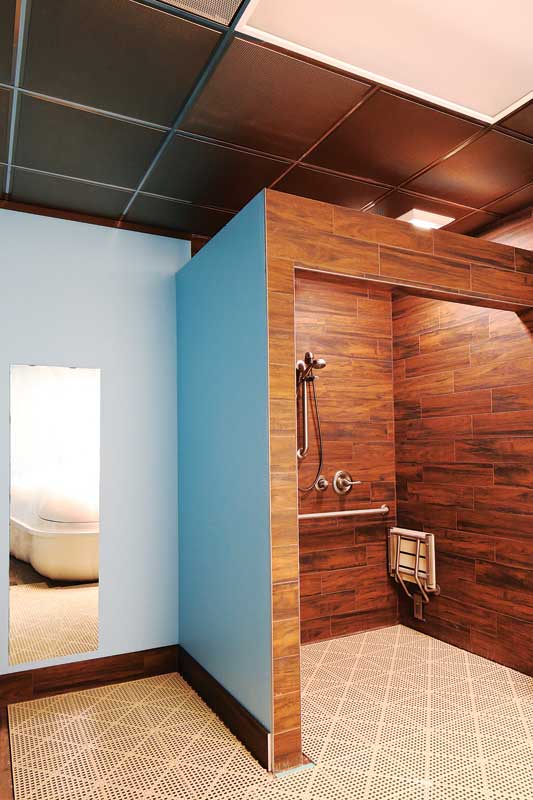
Photos courtesy Ceilume
Metal
Metal panels can have excellent hygienic properties because they are cleanable, do not release fibers or dust, and do not support growth of mold or mildew. They can be produced in large sizes to reduce the number of joints capable of harboring contaminants.
Metal ceilings do not provide significant NRCs unless they have perforations—a feature that can be weighed against a project’s hygienic constraints. Metal panels are not amenable to use in fire-resistance-rated floor-ceiling assemblies.
Anodized aluminum and factory-painted galvanized steel are popular material options. Consideration must be given to exposure to water and chemical fumes with the potential to contribute to corrosion.
Other chemical and physical interactions may also require attention. For example, the Non-traditional Isotope Research on Various Advanced Novel Applications (NIRVANA) laboratory at Woods Hole Oceanographic Institute could not use metal for ceilings or ceiling-mounted light fixtures due to the metal components’ potential to interfere with critical trace metal analysis performed in the lab.
Fiber-reinforced plastic
Fiber-reinforced plastic (FRP) offers significant hygienic advantages, including:
- resistance to moisture, fungi, and bacterial growth;
- chemical and stain resistance; and
- a sanitary, low-maintenance surface with easy cleanability.
FRP panels are available as thin-sheet products or as composites with various laminated backers. They are frequently used as companions to matching wall finishes.
Noise reduction characteristics are minimal with FRP products. Suitability for sound transmission and fire-resistance ratings depends on the backer materials selected. High temperatures above cooking or heating equipment can be a limitation on use.
Mineral fibers and inorganic filler in FRP are encased by polymer binders that reduce the release of naked fibers. Particulates can irritate eyes, skin, and the respiratory system, and chemicals in binders may be a concern in some hygienic situations. Manufacturer installation instructions recommend dust control measures and personal protective equipment when cutting or drilling.
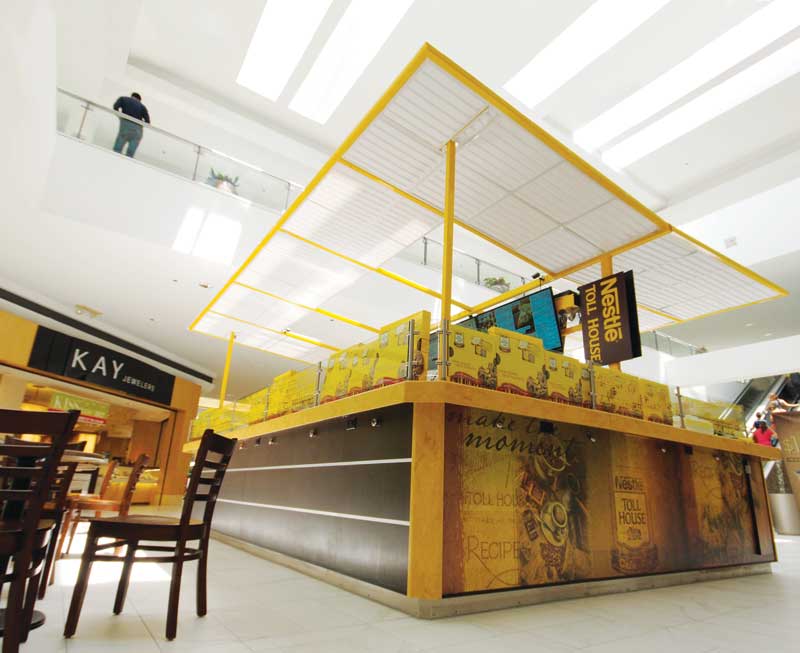
Thermoformed ceiling panels
Thermoformed ceiling panels are produced by molding thermoplastic materials with heat, vacuum, and pressure. Vinyl is the most widely used material for thermoformed ceilings. Its suitability for hygienic ceilings is apparent from everyday encounters with the material demonstrating its resistance to water, cleaning, and common chemicals, and by its use in medical and other products requiring sanitary conditions.
Advances in vinyl manufacturing processes have reduced its environmental burden. Specifiers should require rigid vinyl free from plasticizers, phthalates, and heavy metals. The material is recyclable in most communities as a Type 3 plastic, and some ceiling manufacturers take back jobsite waste and used panels to regrind and extrude into fresh vinyl sheets. Other thermoplastics can also be used, creating opportunities to match material performance with design requirements on a custom basis.
Thermoformed panels are available that have Class A surface burning characteristics and are Class V-0 (self-extinguishing) when tested in accordance with Underwriters Laboratories (UL) 94, Standard for Safety of Flammability of Plastic Materials for Parts in Devices and Appliances. They are not part of fire-resistance-rated floor-ceiling assemblies, but can be installed beneath such assemblies. High temperatures above cooking or heating equipment can be a limitation on use.
Acoustically, these panels act as a diaphragm to transfer noise from an occupied space into the above-ceiling cavity, where acoustical energy dissipates. This provides modest NRC and CAC ratings, which can be boosted with shallow thermoformed pans or a polyester-fiber insulation batts atop the panels. Not known to pose a health risk, the polyester fibers are the same grade as those used for clothing, bedding, and upholstery. Unlike mineral fibers, polyester fibers are long strands, not friable, and unlikely to release significant airborne particles. Neither the acoustical backer pans nor polyester insulation compromise ceiling’s Class A surface burning characteristics. Higher NRCs are achievable if perforated panels are acceptable.
Despite being only 0.33 to 0.76 mm (0.013 to 0.03 in.) thick, thermoformed plastics are robust, able to flex without breakage during handling, and can be trimmed with scissors or snips without producing dust or releasing fibers. Most dirt and stains are removed by simple wiping with a damp cloth or sponge and, if necessary, mild soap or detergent.
Unaffected by moisture, thermoformed panels are not damaged when used in areas that are prone to condensation and leaks. Water from slow or occasional leaks can collect atop panels and then evaporate without damaging them. This may enable the panels to be used instead of special drainage systems beneath sweating pipes and equipment—a requirement in some healthcare and food processing facilities.
Of all the materials discussed in this article, the thermoformed ceiling category is the least well-known. This is not actually a new product, however, given that thermoformed panels were developed in the 1940s and enjoyed popularity in Mid-century Modern design. They are receiving fresh interest for their hygienic properties due to the introduction of new product options, intensive product testing, and new building code evaluation reports. (For more, see a previous article in The Construction Specifier by these three authors. “Thermoformed Ceiling Panels and Tiles” appeared in the September 2014 issue, and is available online at www.constructionspecifier.com/thermoformed-ceiling-panels-and-tiles[2].)
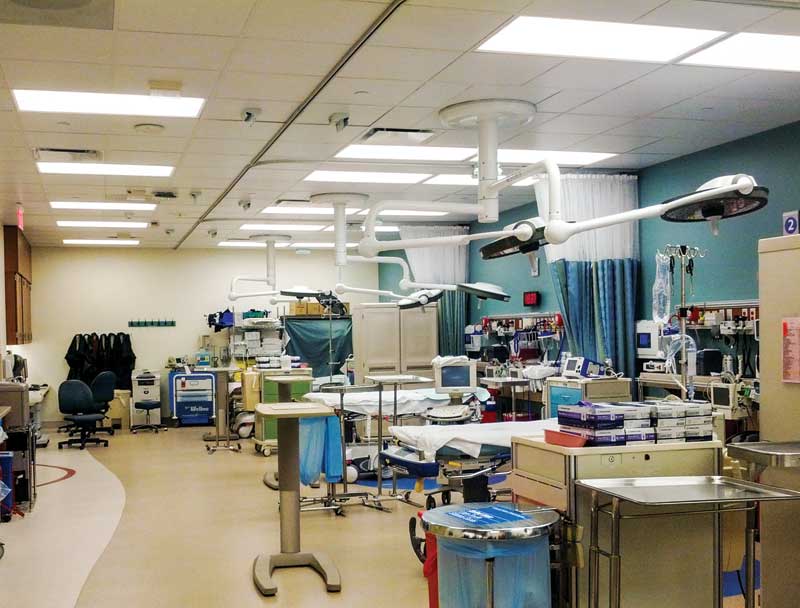
Photo courtesy Walleigh
Topsy-turvy ceilings
To merit consideration as an alternative, thermoformed ceiling panels must offer unique attributes not available with other products. Indeed, thermoformed panels depart from other types of products in two significant ways, both of which involve inverting the normal relationship of a ceiling to fire sprinklers and light fixtures.
Drop-out ceilings
The 2016 edition of National Fire Protection Association (NFPA) 13, Standard for the Installation of Sprinkler Systems, defines a drop-out ceiling as:
a suspended ceiling system, which is installed below the sprinklers, with listed translucent or opaque panels that are heat sensitive and fall from their setting when exposed to heat.
This can be an important factor in designing hygienic spaces, because dirt can accumulate on exposed sprinklers and become a source of contamination. While concealed sprinklers can be used, they require cover plates that add unnecessary crevices and penetrations that may serve as openings for contaminants or insects to enter a space (especially if the space has a negative air pressure) or hinder cleaning.
Keeping sprinklers above ceilings protects them from discharging due to accidental impact or tampering. It also represents significant cost savings compared to extending sprinkler drops to penetrate ceiling panels because the coordination required between sprinkler and ceiling installers is reduced, allowing optimization of sprinkler system layout. In renovation, drop-out panels can be installed beneath existing sprinklers, resulting in additional savings. (For more, see “Drop-out Ceiling Panels Installed Beneath Fire Sprinklers,” a Construction Canada feature from March 2015. Visit www.constructioncanada.net/drop-out-ceiling-panels-installed-beneath-fire-sprinklers[3].)
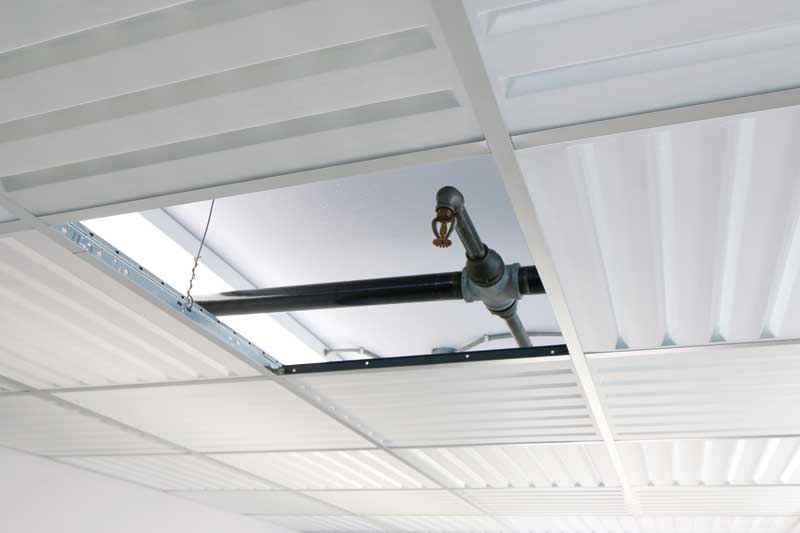
Photos courtesy Ceilume
Luminous ceilings
Light-transmitting vinyl makes it practical to install thermoformed ceiling panels beneath light fixtures or skylights. This option relegates light fixtures to the cavity above the ceiling, outside the hygienic envelope—further reducing ledges and crevices for contaminants, as well as simplifying cleaning. Luminous ceilings can reduce construction costs because strip lights installed above the ceiling are usually less costly than hygienic-grade troffers or other surface-mounted or recessed light fixtures.
Translucent material creates diffuse illumination with little glare. Frosted material blurs the visibility of items above the ceiling and transmits more light than does translucent material, increasing lighting efficiency. Clear material provides even greater lighting efficiency and permits viewing of items on the other side of the ceiling; this feature allows above-ceiling equipment and utilities to be viewed from below, simplifying maintenance.
Putting light fixtures above ceilings improves the odds insects entering the hygienic envelope will be attracted to the area above the ceiling, away from the space requiring clean conditions. Use of the acoustical backer pans keeps insect litter off the ceiling surfaces to limit objectionable shadows. (The layout of lights and sprinklers should also be coordinated in order to minimize shadows.)
Spotting the trends
Contemporary social and technical dynamics could increase interest in hygiene in the built environment.
Antimicrobial treatments
Buildings are implicated in many diseases plaguing contemporary life. In addition to sick-building syndrome and building-related illness, contagious disease can spread rapidly when people live and work in congested facilities. This is most apparent with nosocomial (hospital-acquired) infection; other examples include Legionella that flourishes in warm water systems and salmonella that hides in crevices in food preparation surfaces.
One architectural response to infectious disease has been to specify products, including ceiling panels, with antimicrobial treatments. However, most authorities now recognize widespread use of antimicrobial products can ironically promote increased antimicrobial resistance in pathogens. In September 2016, the U.S. Food and Drug Administration (FDA) banned triclosan and 18 other antibacterial compounds from most consumer goods, saying ordinary soap and water is a healthier and safer way to decontaminate surfaces. (See the online article, “FDA Rule Casts More Doubt on Anti-microbial Building Products,” by Bill Walsh, at www.healthybuilding.net/news/2016/09/07/fda-rule-casts-more-doubt-on-anti-microbial-building-products[4].) While the ban does not apply to building surfaces, the same logic does, suggesting specifiers give more attention to the intrinsic cleanability of products.
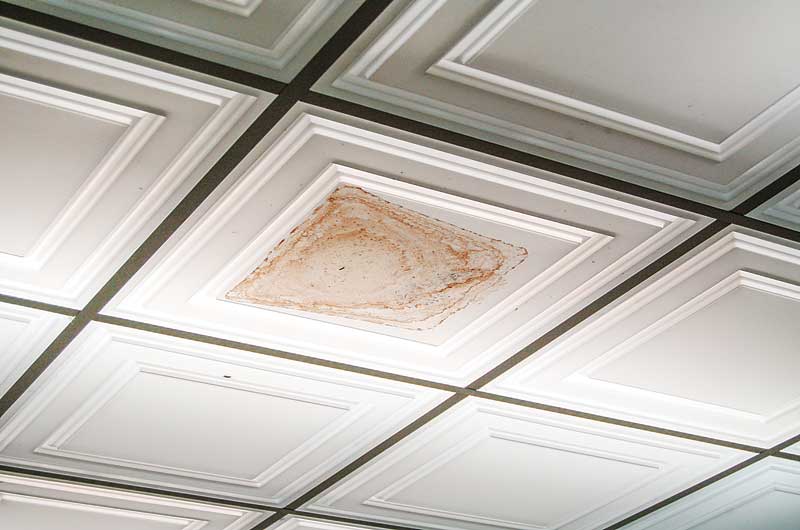
Resiliency
Climate change and other societal issues have prompted an examination of ways to improve the resiliency of our buildings and communities. This was made manifest in May 2016, when President Obama called for an effort to increase resilience through building codes and standards. Hurricanes, tornados, and floods make the headlines, but one of the most effective ways to improve resiliency is simply to use building materials that are not ruined when they get wet. The U.S. Federal Emergency Management Administration (FEMA) publishes guidelines for flood-damage resistant materials. On a scale of 1 (i.e. cannot survive the wetting and drying associated with floods) to 5 (i.e. “permitted for… essentially unmitigated flood exposure”), several types of hygienic ceilings are acceptable as Class 4 materials:
Resistant to floodwater damage from wetting and drying, but less durable when exposed to moving water. These materials can survive wetting and drying and may be successfully cleaned after a flood to render them free of most harmful pollutants. Materials in this class may be exposed to and/or submerged in floodwaters in interior spaces and do not require special waterproofing protection.(See FEMA Technical Bulletin 2, Flood Damage-Resistant Materials Requirements. Visit www.fema.gov/media-library/assets/documents/2655[5].)
Instead of joining the pile of flood-damaged finishes, Class 4 panels can generally be removed from the ceiling suspension grid, washed, and reused.
Nanotechnology
The Institute of Environmental Sciences and Technology (IEST) publishes recommended practices[6] for planning and design of nanoscale science and technology facilities. It points out “Nanotechnology facilities typically require cleanrooms for research and fabrication, but the cleanroom is not the primary focus of the facility.” These facilities have other controlled environments that must be designed to meet diverse requirements, including hygiene.
Indoor air quality
Clean buildings require less ventilation to maintain indoor air quality (IAQ), and thereby reduce energy loads for heating and cooling buildings. The American Society of Heating, Refrigerating, and Air-conditioning Engineers (ASHRAE) states:
A clean indoor environment is generally considered an essential requisite for good IAQ. As part of the design of the building, selecting interior materials and finishes that have surfaces that can be easily cleaned without strong chemical agents is also an important aspect of the overall strategy for controlling cleaning-associated IAQ impacts. Ensuring that these surfaces are also durable will reduce maintenance requirements as well as the IAQ impacts associated with replacement or refinishing. (This comes from ASHRAE’s Indoor Air Quality Guide: Best Practices for Design, Construction, and Commissioning. Visit iaq.ashrae.org[7].)
Ventilation requirements are a greater concern when ceiling materials are able to adsorb and then re-emit odors and VOCs.
Well-being
Hygiene is not only about physical health, but also emotional and mental health. A growing body of evidence from organizations such as the International Well Building Institu[8]te, along with personal observations, supports the conclusion people feel better about themselves and the places where they live, work, study, shop, and play when those spaces are clean and well maintained.
Hygiene in perspective
An n-gram traces the frequency with which a word or phrase is used over time, offering insight into changing behavior. The n-gram graph of the word ‘hygiene’ in English-language books shows it did not start trending until the second half of the 19th century, during the epoch when Pasteur and others developed the germ theory of disease. With the realization cleanliness reduces disease, the richly decorated surfaces of the Victorian Age began evolving into the less fussy styles of the Edwardian Age, and then the austerity of the Modernist architects.
The decline in the term’s use becomes pronounced shortly after 1928, when Fleming discovered penicillin. It is interesting to note the decline of references to hygiene occurs simultaneously with the growing interest in ‘acoustical ceilings.’ Prior to the advent of acoustical ceilings, most ceilings were relatively easily cleaned hard surfaces such as plaster, tin, or painted wood. Perhaps the miracles of modern medicine made it possible for people to overlook hygiene and use difficult-to-clean ceilings that potentially release fibers and support mold.
This is hardly a complete analysis of the complex factors shaping cultural and architectural trends, but it does suggest building design trends are likely influenced by changes in scientific knowledge and the prevailing social paradigms. (For another perspective on this, see the Treehugger article, “Antibiotic Resistance will Change the Way We Live,” by architect Lloyd Alter. Visit www.treehugger.com/urban-design/antibiotic-resistance-will-change-way-we-live.html[9].)
As the trends described in this article gain momentum, hygienic ceilings may well become the new norm.
| DISCERNING CHOICES |
| While searching for subatomic particles, CERN—the European Organization for Nuclear Research—still has to keep ordinary dirt particles out of its computers. In Geneva, Switzerland, its computer center (shown at left) stores, distributes, and analyzes 15 million gigabytes of data generated every year by the Large Hadron Collider (LHC).
The facility uses a hot/cool aisle configuration to keep the computers cool. Filtered, chilled air is pumped into the cool aisles between the front sides of the computer servers. Air heats as it passes through servers, and is exhausted into hot aisles on back sides of servers. A roof over the cool aisles, along with doors at ends of aisles, transforms cold aisles into an enclosed air plenum. The roof is made from light-transmitting plastic ceiling panels that allow the cold aisle to be illuminated from luminaires above the computer racks thus eliminating a heat source from the conditioned space. The hygienic panels are easy to clean and do not release dust, fibers, or other contaminants into the servers. The grid supporting the panels spans between server racks. |
For more on “Hygienic Ceilings: Standards and Guidelines,” along with an n-gram of “hygiene,” see these authors’ article posted on The Construction Specifier website. Visit www.constructionspecifier.com/more-hygienic-ceilings[1].
Ed Davis is president of Ceilume, a manufacturer of thermoformed ceiling products. He has been responsible for product testing and code compliance. Davis can be reached via www.ceilume.com/pro[10].
David Condello has more than 20 years of experience in construction, and is architectural services manager for Ceilume. He can be contacted through www.ceilume.com/pro[10].
Michael Chusid, RA, FCSI, CCS, is a frequent contributor to this magazine, and received the 2015 The Construction Specifier Article of the Year Award from CSI. He is an authority in building product innovation. Chusid can be reached via www.chusid.com[11].
- www.constructionspecifier.com/more-hygienic-ceilings: http://www.constructionspecifier.com/more-hygienic-ceilings
- www.constructionspecifier.com/thermoformed-ceiling-panels-and-tiles: http://www.constructionspecifier.com/thermoformed-ceiling-panels-and-tiles
- www.constructioncanada.net/drop-out-ceiling-panels-installed-beneath-fire-sprinklers: http://www.constructioncanada.net/drop-out-ceiling-panels-installed-beneath-fire-sprinklers
- www.healthybuilding.net/news/2016/09/07/fda-rule-casts-more-doubt-on-anti-microbial-building-products: http://www.healthybuilding.net/news/2016/09/07/fda-rule-casts-more-doubt-on-anti-microbial-building-products
- www.fema.gov/media-library/assets/documents/2655: http://www.fema.gov/media-library/assets/documents/2655
- recommended practices: http://www.iest.org/Standards-RPs/Recommended-Practices/IEST-RP-NANO200
- iaq.ashrae.org: http://iaq.ashrae.org
- International Well Building Institu: http://www.wellcertified.com
- www.treehugger.com/urban-design/antibiotic-resistance-will-change-way-we-live.html: http://www.treehugger.com/urban-design/antibiotic-resistance-will-change-way-we-live.html
- www.ceilume.com/pro: http://www.ceilume.com/pro
- www.chusid.com: http://www.chusid.com
Source URL: https://www.constructionspecifier.com/hygienic-ceilings-keeping-it-clean-overhead/